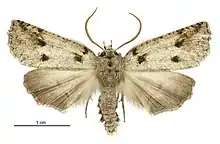Declana floccosa
Declana floccosa, the forest semilooper, is a moth of the family Geometridae. It is endemic to New Zealand.[1] It was first described by Francis Walker in 1863 using specimens obtained from Colonel Bolton.[2]
| Declana floccosa | |
|---|---|
 | |
| Male specimen | |
 | |
| Female specimen | |
| Scientific classification | |
| Kingdom: | |
| Phylum: | |
| Class: | |
| Order: | |
| Family: | |
| Genus: | |
| Species: | D. floccosa |
| Binomial name | |
| Declana floccosa | |
| Synonyms[1] | |
| |
The wingspan of this species is 27–35 mm and is extremely variable in colour and patterning.[3][4]
The larvae feed on a wide range of native and exotic broad-leaved and coniferous shrubs and trees.[5] Exotic hosts include Pinus radiata and other Pinus species, Pseudotsuga menziesii, Larix and Eucalyptus.[3] Native hosts include Muehlenbeckia australis.[6]
References
- "Declana floccosa Walker, 1858". www.nzor.org.nz. Landcare Research New Zealand. Retrieved 7 February 2017.
- Walker, Francis (1858). "Noctuidae". List of the specimens of lepidopterous insects in the collection of the British Museum. 15: 1521–1888 – via Biodiversity Heritage Library.
- "Declana floccosa, forest semilooper". www.nzffa.org.nz. New Zealand Farm Forestry Association. Retrieved 7 February 2017.
- Hudson, George Vernon (1888). "On the varieties of a common moth (Declana floccosa)". Transactions and Proceedings of the New Zealand Institute. 21: 190–193 – via Biodiversity Heritage Library.
- "PlantSynz - Invertebrate herbivore biodiversity assessment tool: Database". plant-synz.landcareresearch.co.nz. Retrieved 2018-07-10.
- Patrick, Brian (18 May 2016). "Ecological importance of Muehlenbeckia australis/Pohuehue". www.openspace.org.nz. Retrieved 2017-02-07.
External links
| Wikimedia Commons has media related to Declana floccosa. |
| Wikispecies has information related to Declana floccosa. |
- Citizen science observations of D. floccosa.
- Specimens held at the Auckland Museum.
- Image of Declana floccosa Walker, 1858; holotype of Declana callista Salmon, 1946 held at Te Papa Tongarewa Museum of New Zealand.
This article is issued from Wikipedia. The text is licensed under Creative Commons - Attribution - Sharealike. Additional terms may apply for the media files.